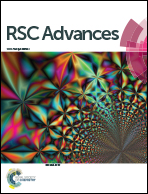A sensitive and selective fluorescent probe for hydrazine with a unique nonaromatic fluorophore†
Abstract
To achieve sensitive, selective and facile detection of hydrazine in environmental and biological systems, a fluorescent probe (Che-Dcv) with a unique nonaromatic fluorophore was developed. Upon hydrazine addition in 20% DMSO–PBS buffer (pH = 7.4, 10 mM, v/v) at room temperature, the probe displayed a strong emission at 496 nm along with a color change from brown-red to yellow. The response was attributed to the reaction of dicyanovinyl groups with hydrazine to afford hydrazone, which was supported by 1H NMR and HRMS. The detection limit of Che-Dcv for hydrazine was estimated to be as low as 1.08 ppb and good selectivity over amines including hydroxylamine was observed. Then, the potential of probe-coated test papers to detect hydrazine in solution and vapor phase was demonstrated. Moreover, the bioimaging of hydrazine in living H1975 cells was performed successfully.



 Please wait while we load your content...
Please wait while we load your content...